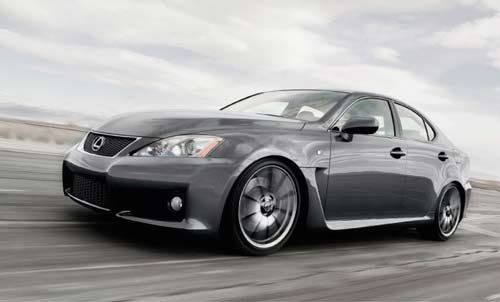Lexus IS F
Lexus by name, hot rod by nature: Their usual purring, smooth engines have been taken over by the IS F – a menacing, growling machine that cries out to be raced

Specifications:
Model: Lexus IS F
Price: £51,000
Engine 4,969cc, V8 cylinders, 32 valves, 423bhp at 6,600rpm, 372lb ft at 5,200rpm
Transmission: eight-speed automatic/sequential gearbox, rear-wheel drive
Performance: 168mph, 0-62 in 4.8sec, 24.8mpg official average, CO2 270g/km
As a brand matures, it develops a base from which it can diversify. Take Mercedes-Benz, the oldest car brand in the world. It can create practically anything, but observers will still equate that anything with trusted German quality and intelligent engineering. Start a new brand, though, and it has to be focused, concise. That's what Lexus had to do in 1989.
There was, initially, just one Lexus. The LS400 was exquisitely engineered and ran with startling smoothness and quietness. The US, more open to the idea of a high-quality Japanese car, took to Lexus quickly. It took longer in Europe partly because early Lexuses were hardly objects of beauty. Today's range has a sharper, cleaner style and is more appealing.
What are we to make of the mutant portrayed here? The first encounter with an IS F is a bit of a shock. You don't expect a car with a Lexus badge to be this extreme. It makes an AMG Mercedes seem almost demure.
Start it up. The engine awakes not with the usual Lexus purr but a slightly metallic, beating growl. Move off and hear the seismic activity escalate at the far end of the four exhaust pipes. Forget L-Finesse, Lexus's term for its design language and way of doing things. This is L-Fire.
This engine is a 5.0-litre V8 with 423bhp on tap; the huge Brembo brakes have six pistons in each front caliper; the 19in wheels are ultra-light and the beast can run to an electronically limited 168mph given the space and place. Oh, and it passes 62mph (a round metric 100km/h) 4.8 seconds after its blast-off. As for CO2, it could be worse: 270g/km is not at all bad for something of this pace.
And look at it. The IS F (F stands not for Fast, by the way, but Fuji, the race circuit used for development testing) sits low on its stiffened, lightened, strengthened suspension, skeletal wheels revealing those massive brakes. The nose is longer and more bulbous to accommodate the V8. Inside are rubber-studded aluminium pedals, a silvery carbon-fibre-look lacquered weave, and paddle-shifters on the steering wheel for manual control of the eight-speed (yes, eight) automatic transmission. As for the V8 engine, it deserves a paragraph all to itself.
It is derived from the engine that supplies most of the motive force to the hybrid LS600h. There are similar-looking but entirely new cylinder heads with better airflow at high speeds, but they retain the engineering extravagance of having both direct fuel injection into the cylinders and seemingly older-tech indirect injection into the inlet ports. Why have two separate systems? Simply because the engineers wanted to avoid the compromises associated with each system and thought it worth the expense.
We're out on the open road and the IS F is signally failing to conform to normal Lexus standards. As the engine passes 3,600rpm a second set of inlet tracts opens and the resultant visceral boom makes my ears ring. All the while the suspension is fidgeting impatiently, and you do your best to avoid sharp bumps and ridges because the resultant thuds are not nice.
Is this a mutant too far? It's certainly not as rounded in its abilities as its German rivals. The steering, for example, is incongruously soft and polite in its responses compared with the sometimes imperfect gearshifts. Sport mode gives a smoother drive because it makes the transmission less prone to surges.
And so we arrive at a racetrack. Sport manual mode is now the transmission setting, with the traction and stability system also set to sport mode. You can turn it off but even pro test drivers are faster and smoother with it on. That's how clever these systems have become.
It soon becomes clear that there's no point in trying to be brisk but smooth. The transmission is too abrupt for that. It's better to drive it as though you're in a race, braking late and hard, turning hard into corners to load up the tyres, balancing acceleration against steering.
By now you've almost forgotten you're driving a Lexus. You're simply in a very fast, thrillingly vocal hot rod. As a road car it's not as well resolved as its rivals. As a track machine it's brilliant. As a Lexus, it might just be a brand extension too far.
The Rivals
Mercedes-Benz C63 AMG: from £60,000
Available soon, ultimate C-class has a giant 6.2-litre V8 with 457bhp. Zero to 62mph in 4.5 seconds, seven-speed auto with 'blip' downshifts, lovely steering.
Vauxhall VXR8: from £35,105
Australian-built and bigger than rivals, VXR8 has Corvette-based 6.0-litre V8 with 417bhp. Simple mechanicals and cheap trim, but huge pace (and thirst) plus big space.
BMW M3: from £49,415
Now available as a four-door saloon with more fluid responses than coupé, M3 has a 4.0-litre, 420bhp V8 able to reach 8,400rpm. Thirstier than Lexus but more civilised.
Subscribe to Independent Premium to bookmark this article
Want to bookmark your favourite articles and stories to read or reference later? Start your Independent Premium subscription today.

Join our commenting forum
Join thought-provoking conversations, follow other Independent readers and see their replies